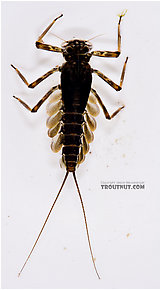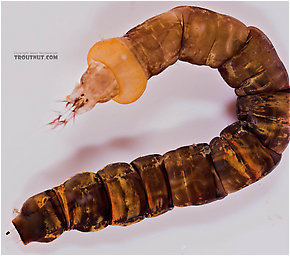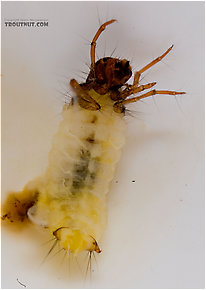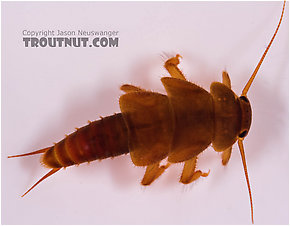Blog & Latest Updates
Fly Fishing Articles
Insects by Common Name


> > Mongaup Creek
Closeup insects from Mongaup Creek
Female Baetis (Blue-Winged Olives) Mayfly Dun View 7 PicturesThis little early-season dun molted into this spinner after I photographed her.
View 7 PicturesThis little early-season dun molted into this spinner after I photographed her.
 View 7 PicturesThis little early-season dun molted into this spinner after I photographed her.
View 7 PicturesThis little early-season dun molted into this spinner after I photographed her.Collected April 19, 2006 from Mongaup Creek in New York
Added to Troutnut.com by Troutnut on April 21, 2006
Added to Troutnut.com by Troutnut on April 21, 2006
Epeorus (Little Maryatts) Mayfly Nymph View 9 Pictures
View 9 Pictures
 View 9 Pictures
View 9 PicturesCollected May 6, 2007 from Mongaup Creek in New York
Added to Troutnut.com by Troutnut on May 18, 2007
Added to Troutnut.com by Troutnut on May 18, 2007
Cottidae (Sculpins) Sculpin Adult View 7 PicturesThis seems to be a mottled sculpin, Cottus bairdi. Normally this species is more mottled.
View 7 PicturesThis seems to be a mottled sculpin, Cottus bairdi. Normally this species is more mottled.
 View 7 PicturesThis seems to be a mottled sculpin, Cottus bairdi. Normally this species is more mottled.
View 7 PicturesThis seems to be a mottled sculpin, Cottus bairdi. Normally this species is more mottled.Collected May 6, 2007 from Mongaup Creek in New York
Added to Troutnut.com by Troutnut on May 18, 2007
Added to Troutnut.com by Troutnut on May 18, 2007
Hexatoma True Fly Larva View 6 PicturesI'm not sure if this cranefly larva is in the genus Hexatoma or Limnophila, but the habitat suggests Hexatoma. Its coloring is iridescent, and I've never heard of that before. However, there is an insect virus genus Iridovirus which can infect craneflies and causes iridescence. It has not been reported in this region as far as I can tell, but perhaps it is the culprit. It makes for beautiful pictures.
View 6 PicturesI'm not sure if this cranefly larva is in the genus Hexatoma or Limnophila, but the habitat suggests Hexatoma. Its coloring is iridescent, and I've never heard of that before. However, there is an insect virus genus Iridovirus which can infect craneflies and causes iridescence. It has not been reported in this region as far as I can tell, but perhaps it is the culprit. It makes for beautiful pictures.
 View 6 PicturesI'm not sure if this cranefly larva is in the genus Hexatoma or Limnophila, but the habitat suggests Hexatoma. Its coloring is iridescent, and I've never heard of that before. However, there is an insect virus genus Iridovirus which can infect craneflies and causes iridescence. It has not been reported in this region as far as I can tell, but perhaps it is the culprit. It makes for beautiful pictures.
View 6 PicturesI'm not sure if this cranefly larva is in the genus Hexatoma or Limnophila, but the habitat suggests Hexatoma. Its coloring is iridescent, and I've never heard of that before. However, there is an insect virus genus Iridovirus which can infect craneflies and causes iridescence. It has not been reported in this region as far as I can tell, but perhaps it is the culprit. It makes for beautiful pictures.Collected April 19, 2006 from Mongaup Creek in New York
Added to Troutnut.com by Troutnut on April 21, 2006
Added to Troutnut.com by Troutnut on April 21, 2006
Ephemerella aurivillii Mayfly Nymph View 6 PicturesThis specimen was collected together with a lighter one of the same species.
View 6 PicturesThis specimen was collected together with a lighter one of the same species.
It resembles another specimen from about 1300 miles away in Wisconsin, which I tentatively called Ephemerella needhami. This one has much less prominent abdominal tubercles ( Tubercle: Various peculiar little bumps or projections on an insect. Their character is important for the identification of many kinds of insects, such as the nymphs of Ephemerellidae mayflies.). It may be that they're both the same species and I don't have my identifications straight.
Tubercle: Various peculiar little bumps or projections on an insect. Their character is important for the identification of many kinds of insects, such as the nymphs of Ephemerellidae mayflies.). It may be that they're both the same species and I don't have my identifications straight.
 View 6 PicturesThis specimen was collected together with a lighter one of the same species.
View 6 PicturesThis specimen was collected together with a lighter one of the same species.It resembles another specimen from about 1300 miles away in Wisconsin, which I tentatively called Ephemerella needhami. This one has much less prominent abdominal tubercles (

A few (not all) of the abdominal tubercles on this Ephemerella needhami nymph are circled. They are especially large in this species.
Collected April 19, 2006 from Mongaup Creek in New York
Added to Troutnut.com by Troutnut on April 21, 2006
Added to Troutnut.com by Troutnut on April 21, 2006
Stenonema femoratum (Cream Cahill) Mayfly Nymph View 6 Pictures
View 6 Pictures
 View 6 Pictures
View 6 PicturesCollected May 6, 2007 from Mongaup Creek in New York
Added to Troutnut.com by Troutnut on May 18, 2007
Added to Troutnut.com by Troutnut on May 18, 2007
Lepidostoma (Little Brown Sedges) Little Brown Sedge Larva View 6 PicturesThis one got a little bit damaged in the abdomen when I extracted it from its case. That's a delicate job.
View 6 PicturesThis one got a little bit damaged in the abdomen when I extracted it from its case. That's a delicate job.
 View 6 PicturesThis one got a little bit damaged in the abdomen when I extracted it from its case. That's a delicate job.
View 6 PicturesThis one got a little bit damaged in the abdomen when I extracted it from its case. That's a delicate job.Collected May 6, 2007 from Mongaup Creek in New York
Added to Troutnut.com by Troutnut on May 18, 2007
Added to Troutnut.com by Troutnut on May 18, 2007
Rhithrogena impersonata (Dark Red Quill) Mayfly Nymph View 6 PicturesThis was the only Rhithrogena specimen in a large sample of nymphs from a small Catskill stream. It looks virtually identical to Rhithrogena impersonata specimens collected in the Midwest, but I didn't get to check the distinguishing features under a microscope.
View 6 PicturesThis was the only Rhithrogena specimen in a large sample of nymphs from a small Catskill stream. It looks virtually identical to Rhithrogena impersonata specimens collected in the Midwest, but I didn't get to check the distinguishing features under a microscope.
 View 6 PicturesThis was the only Rhithrogena specimen in a large sample of nymphs from a small Catskill stream. It looks virtually identical to Rhithrogena impersonata specimens collected in the Midwest, but I didn't get to check the distinguishing features under a microscope.
View 6 PicturesThis was the only Rhithrogena specimen in a large sample of nymphs from a small Catskill stream. It looks virtually identical to Rhithrogena impersonata specimens collected in the Midwest, but I didn't get to check the distinguishing features under a microscope.Collected April 19, 2006 from Mongaup Creek in New York
Added to Troutnut.com by Troutnut on April 21, 2006
Added to Troutnut.com by Troutnut on April 21, 2006
Tallaperla (Roachflies) Stonefly Nymph View 6 PicturesThis is the first specimen of the Peltoperlidae stonefly family that I've collected. It's very small and probably an early instar (Instar: Many invertebrates molt through dozens of progressively larger and better-developed stages as they grow. Each of these stages is known as an instar. Hard-bodied nymphs typically molt through more instars than soft-bodied larvae.), but I'm not choosy about new bugs.
View 6 PicturesThis is the first specimen of the Peltoperlidae stonefly family that I've collected. It's very small and probably an early instar (Instar: Many invertebrates molt through dozens of progressively larger and better-developed stages as they grow. Each of these stages is known as an instar. Hard-bodied nymphs typically molt through more instars than soft-bodied larvae.), but I'm not choosy about new bugs.
 View 6 PicturesThis is the first specimen of the Peltoperlidae stonefly family that I've collected. It's very small and probably an early instar (Instar: Many invertebrates molt through dozens of progressively larger and better-developed stages as they grow. Each of these stages is known as an instar. Hard-bodied nymphs typically molt through more instars than soft-bodied larvae.), but I'm not choosy about new bugs.
View 6 PicturesThis is the first specimen of the Peltoperlidae stonefly family that I've collected. It's very small and probably an early instar (Instar: Many invertebrates molt through dozens of progressively larger and better-developed stages as they grow. Each of these stages is known as an instar. Hard-bodied nymphs typically molt through more instars than soft-bodied larvae.), but I'm not choosy about new bugs.Collected April 19, 2006 from Mongaup Creek in New York
Added to Troutnut.com by Troutnut on April 21, 2006
Added to Troutnut.com by Troutnut on April 21, 2006
Neoleptophlebia Mayfly Nymph View 6 Pictures
View 6 Pictures
 View 6 Pictures
View 6 PicturesCollected April 19, 2006 from Mongaup Creek in New York
Added to Troutnut.com by Troutnut on April 21, 2006
Added to Troutnut.com by Troutnut on April 21, 2006
Start a Discussion of Mongaup Creek:
Top 10 Fly Hatches
Top Gift Shop Designs
Eat mayflies.
Top Insect Specimens
Miscellaneous Sites
Troutnut.com is copyright © 2004-2024 Jason
Neuswanger (email Jason). See my FAQ for information about use of my images.
 privacy policy
privacy policy
